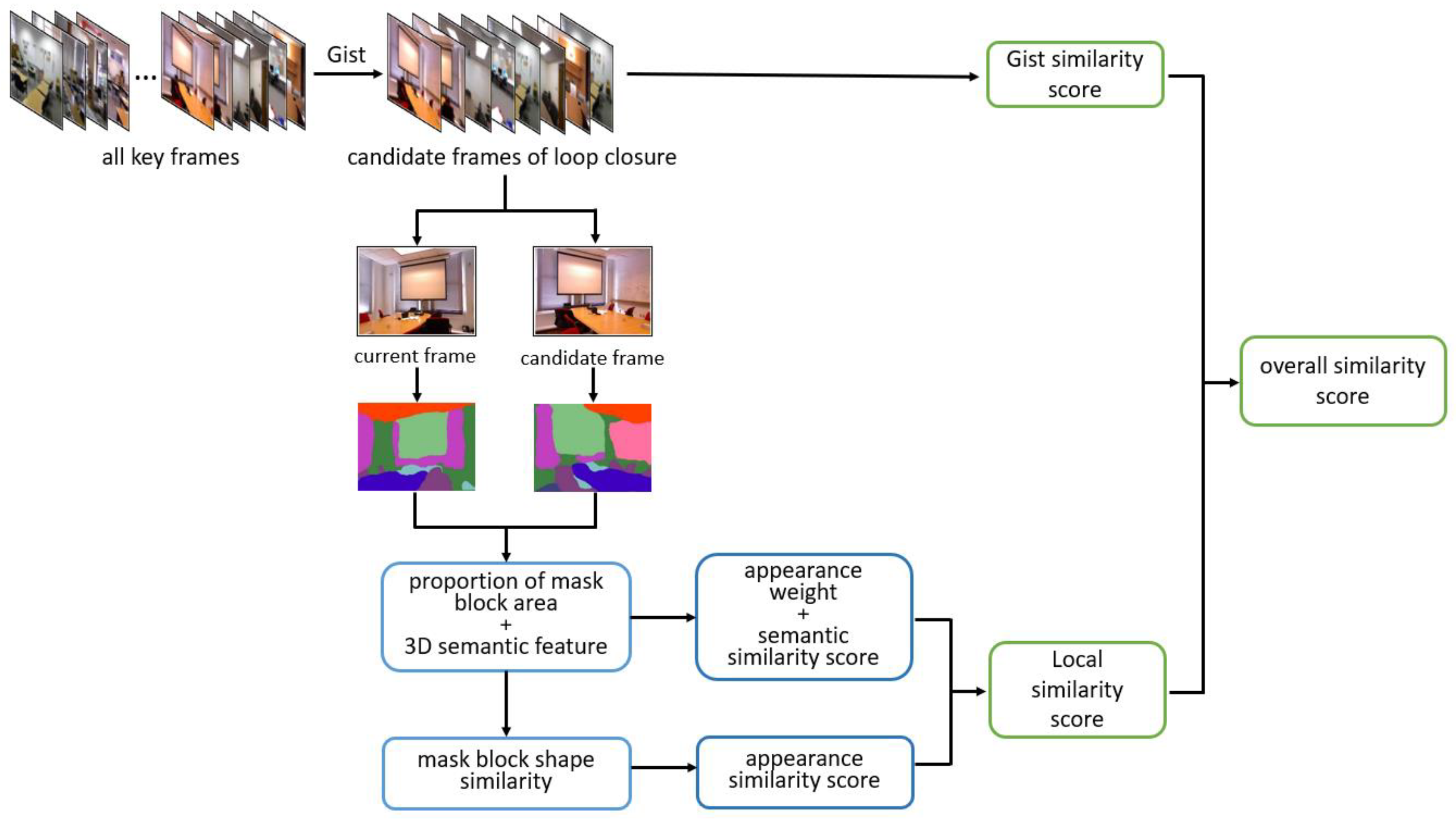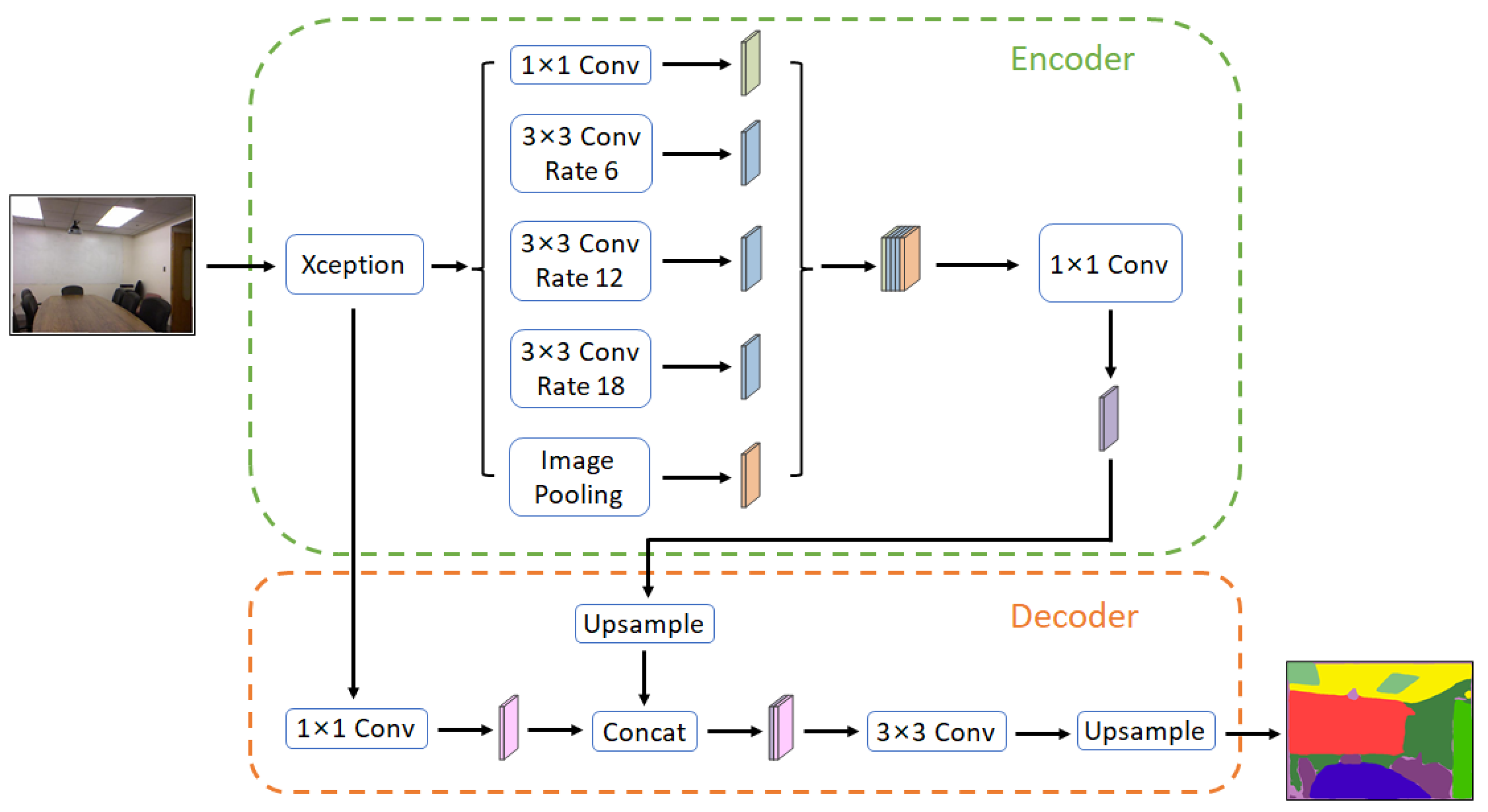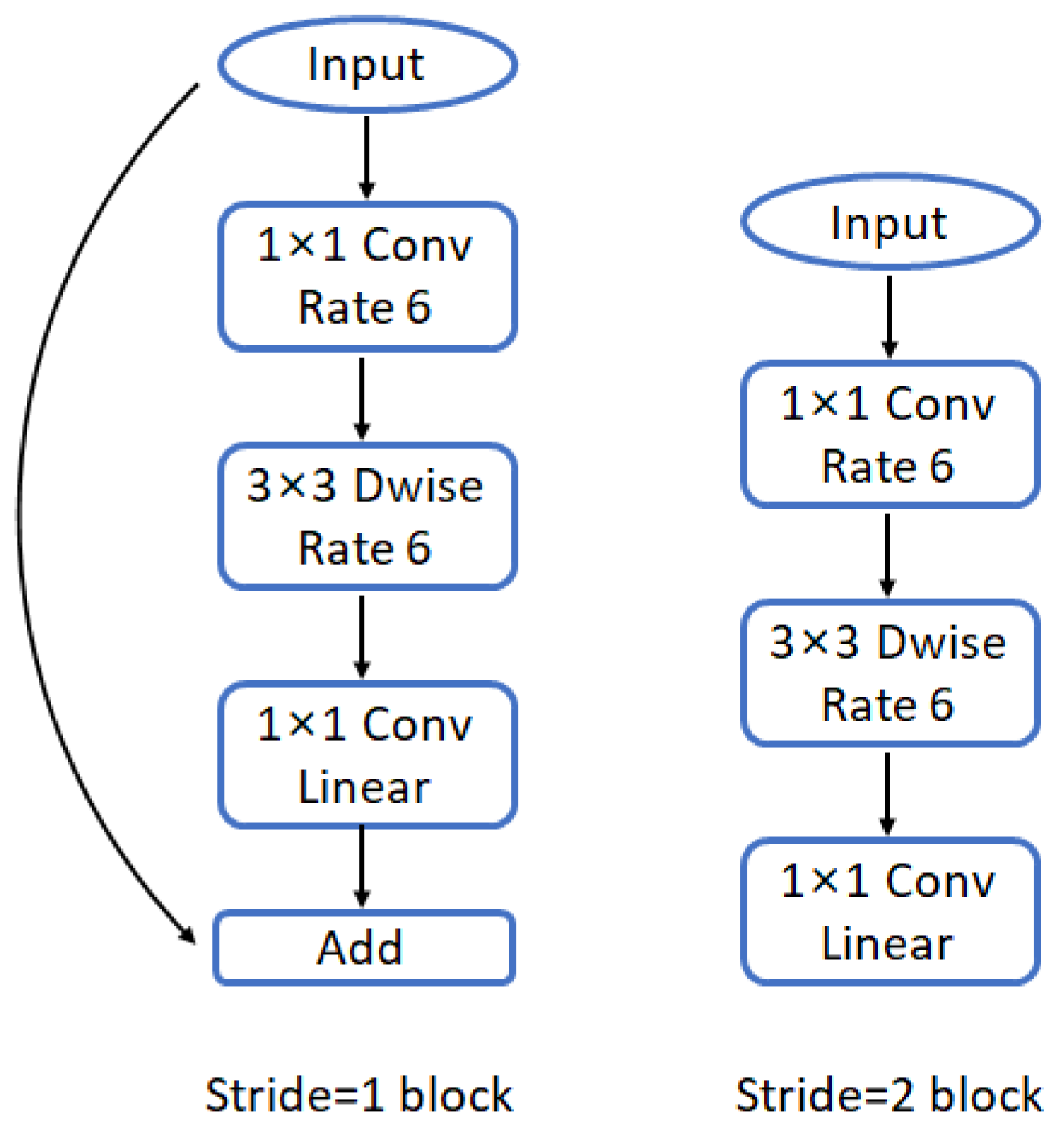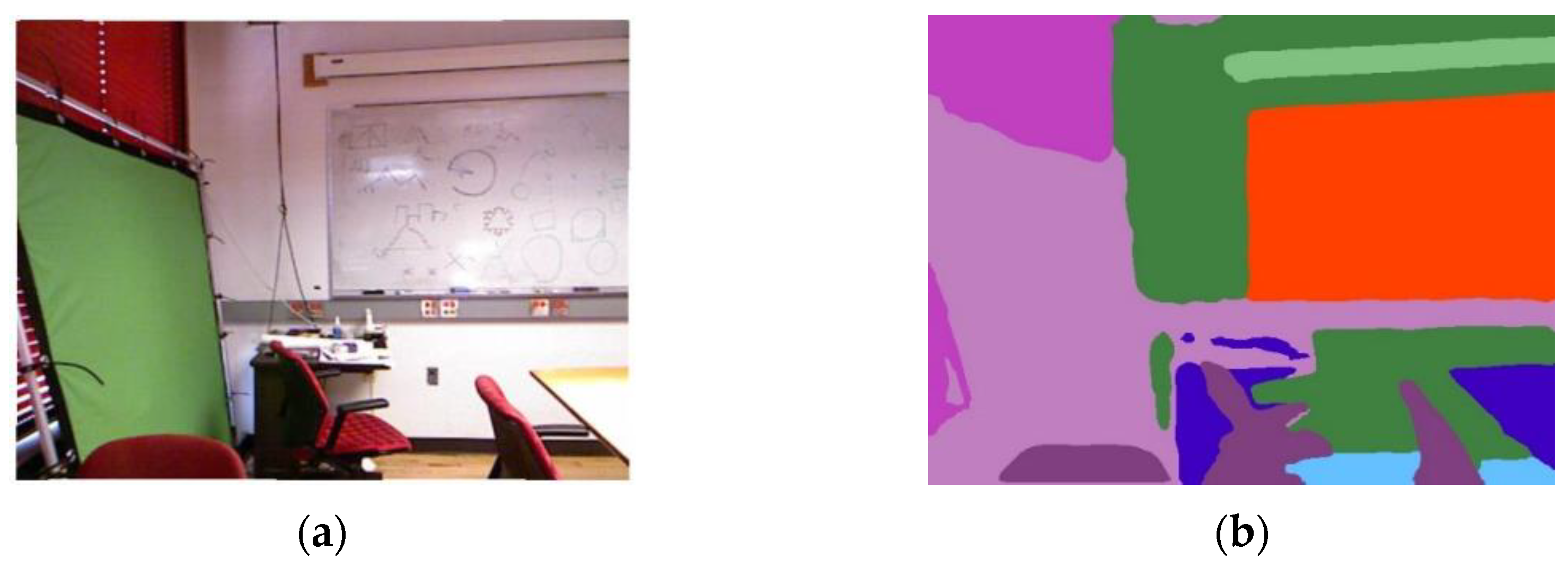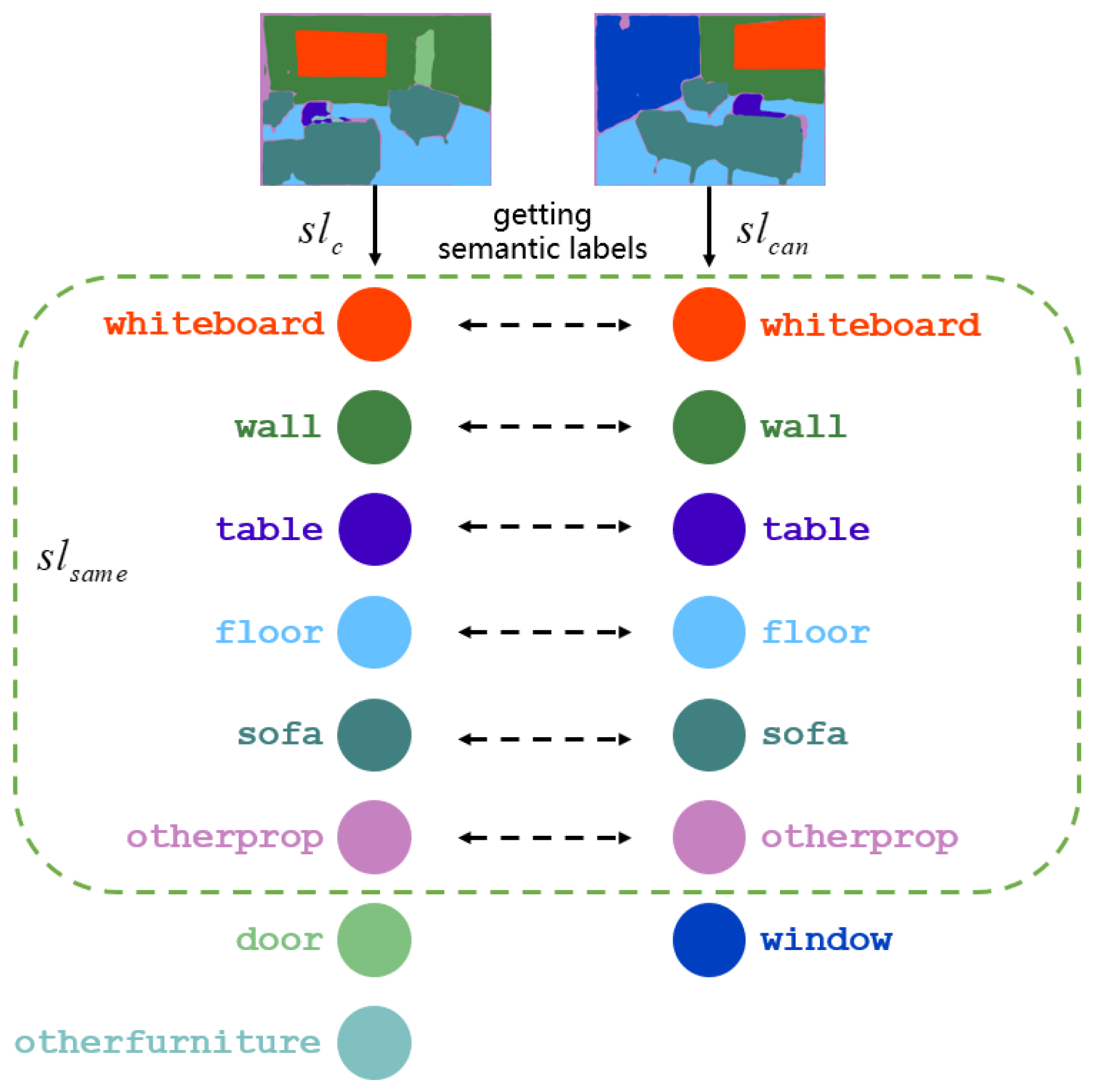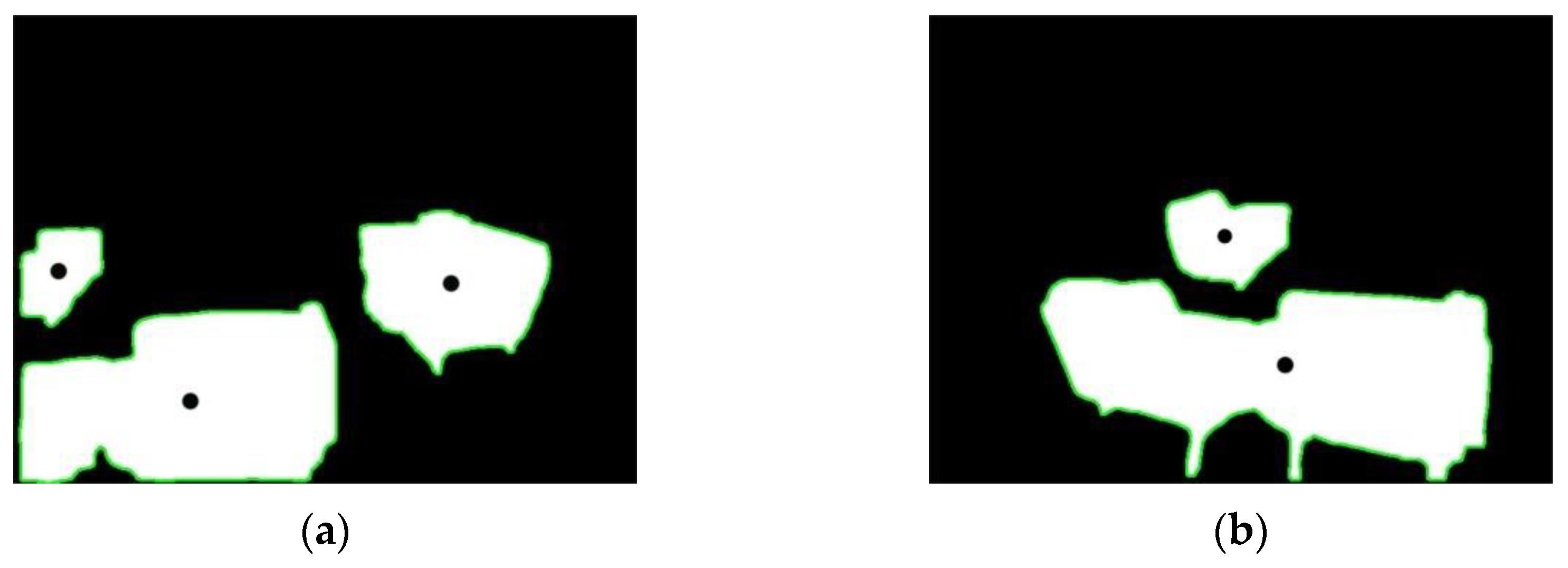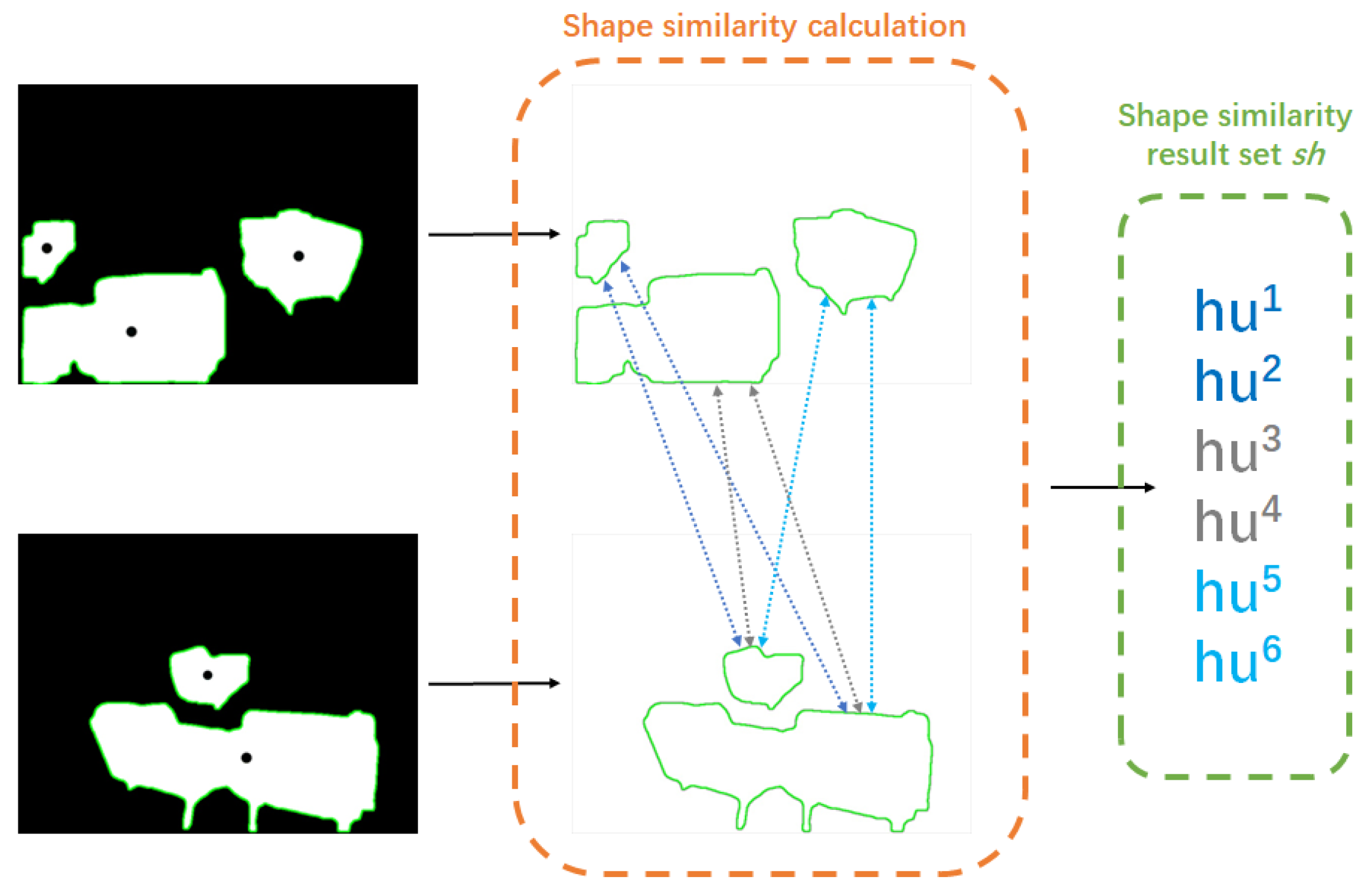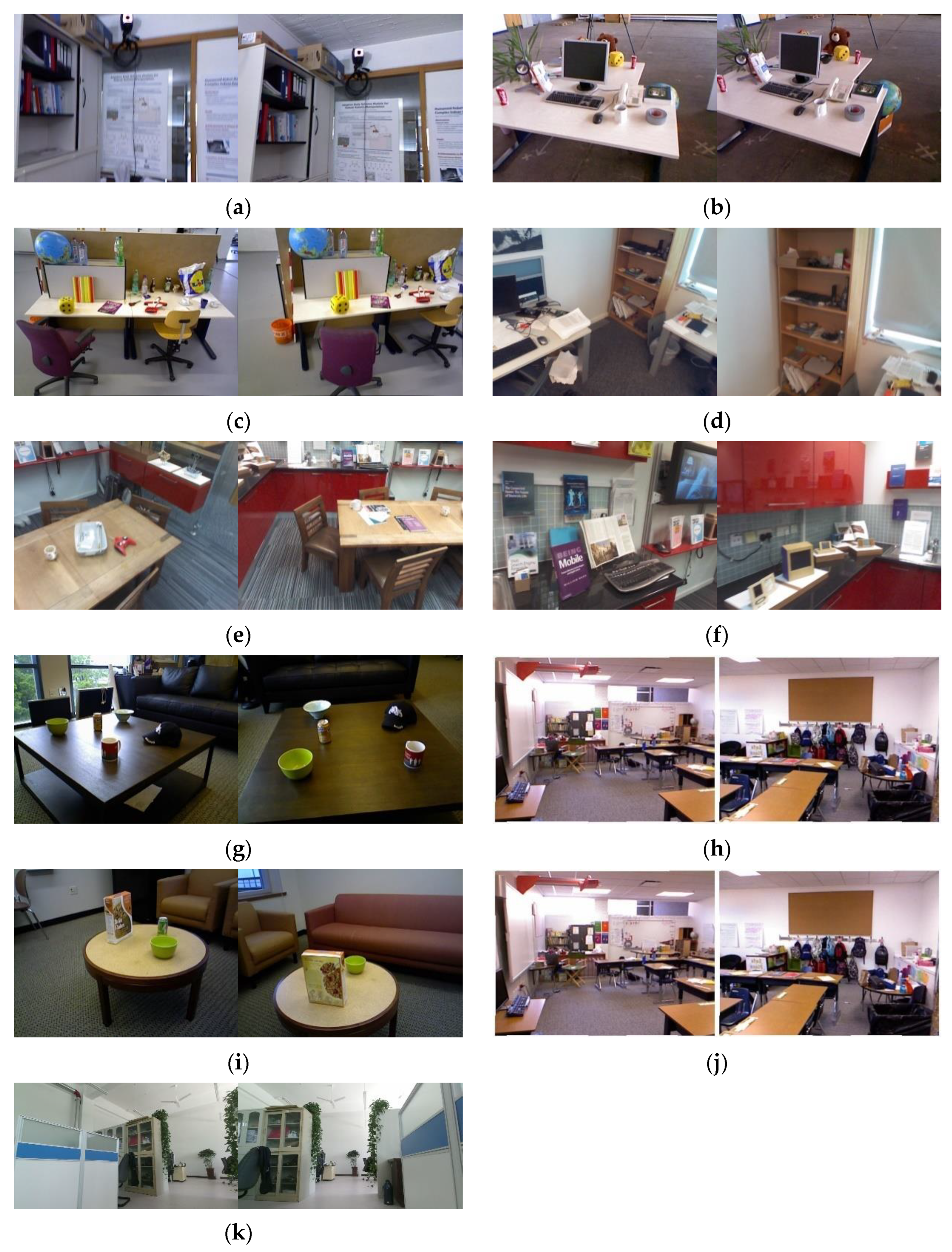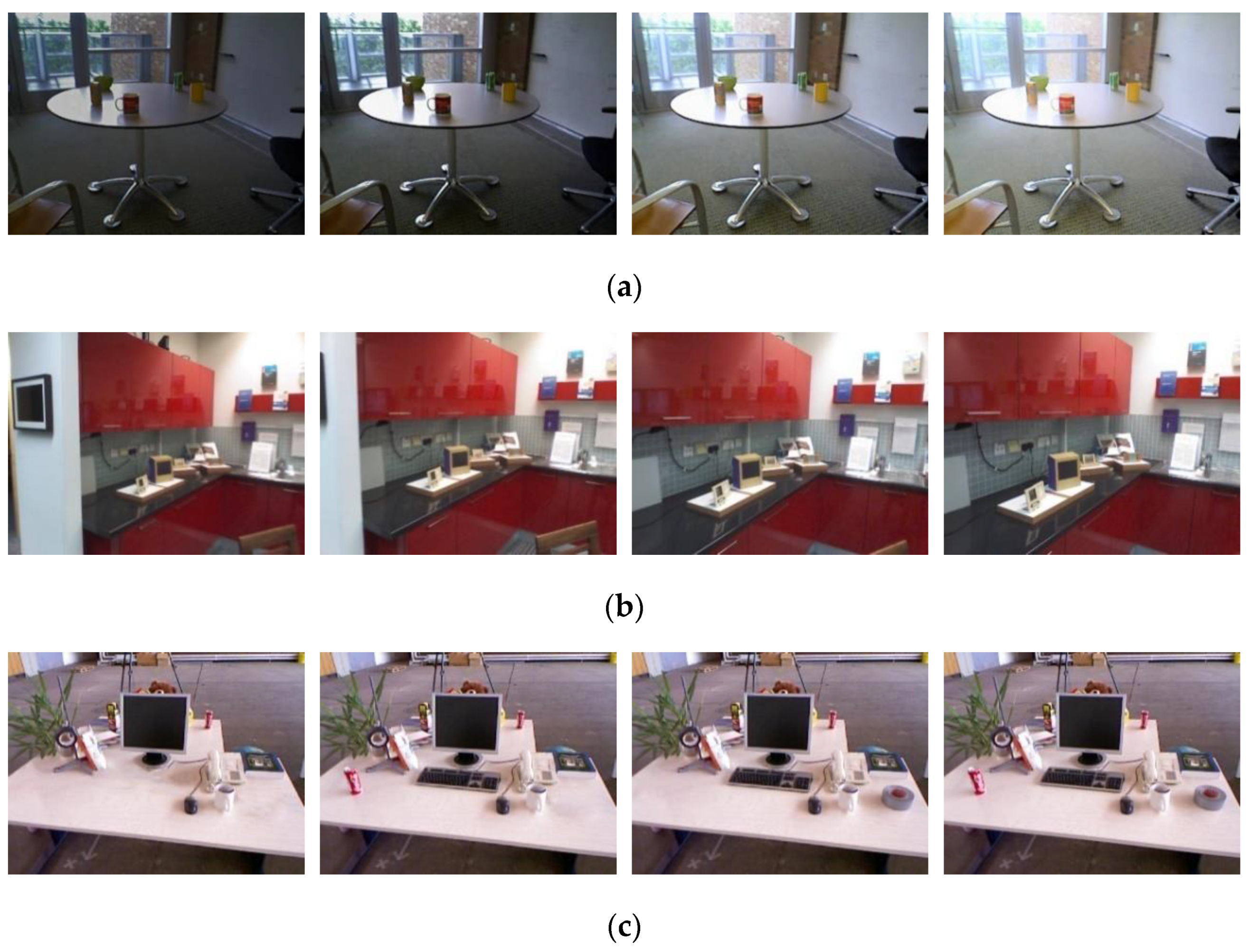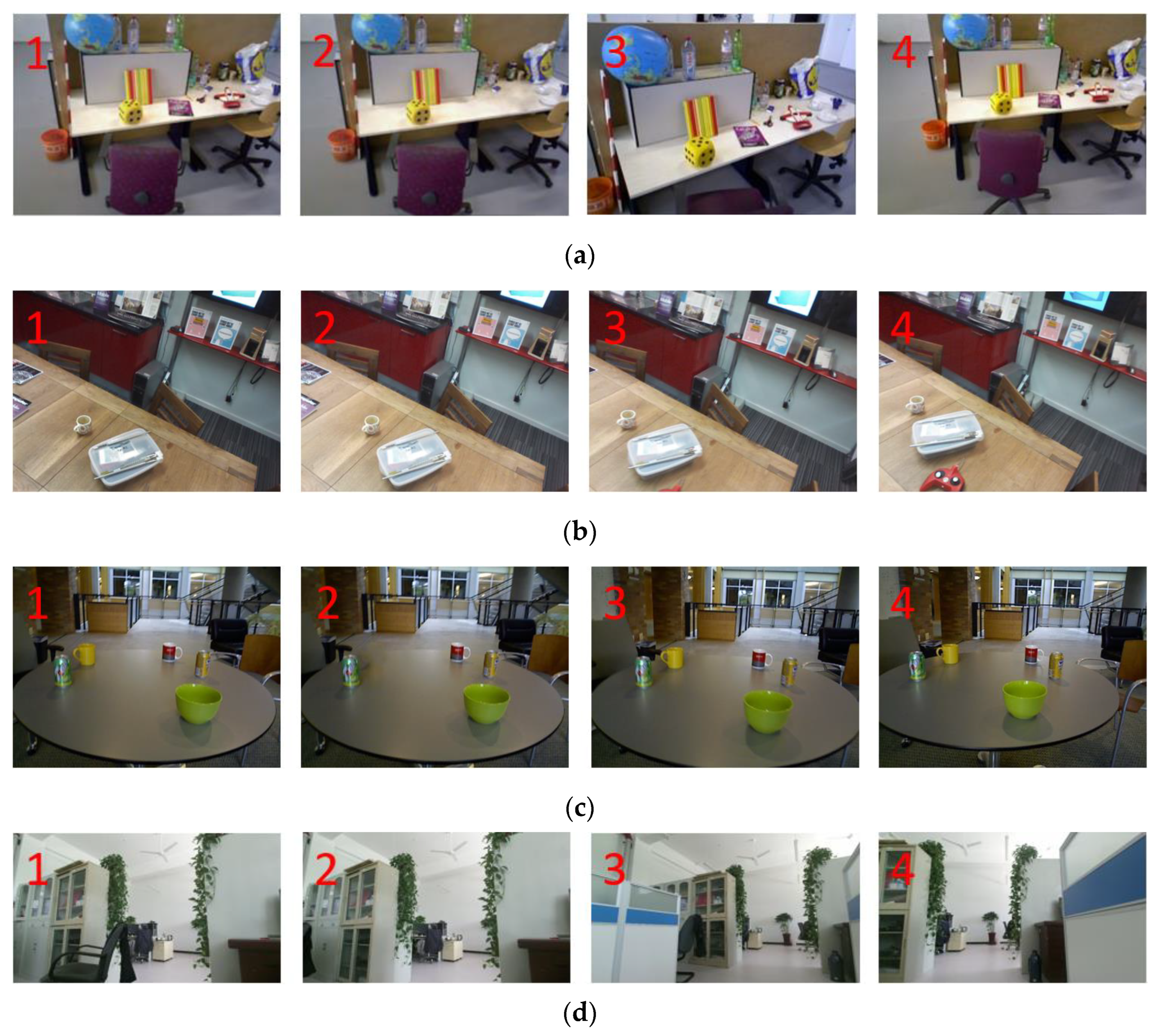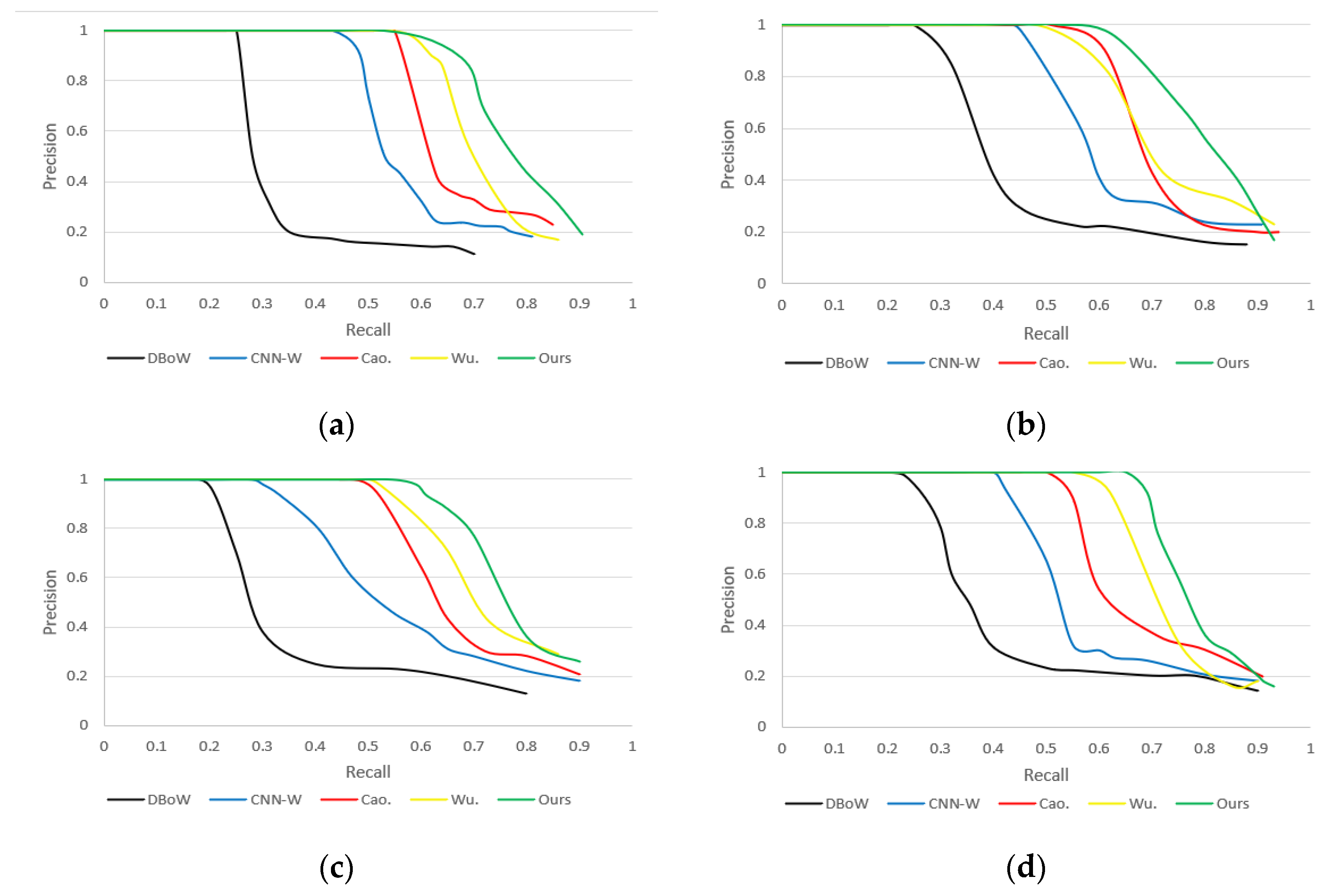1. Introduction
Vision-based simultaneous localization and map building (VSLAM) refers to a mobile robot outfitted with vision sensors that acquire and analyze images of its surroundings in order to position itself and build a map in real-time. Currently, VSLAM is widely used in robotics and visual navigation. During the operation of VSLAM, both the visual sensor and the robot’s motion estimation will generate errors, and if the errors continue to accumulate, they will seriously impair the mobile robot’s judgment of its positioning and may even result in map construction failure [
1]. Loop closure detection [
2] is primarily used to determine whether the mobile robot’s current position has been visited previously, which can effectively reduce the accumulated errors and achieve repositioning after the robot has lost its position, helping to ensure accurate positioning and map construction. The loop closure detection in the existing VSLAM system primarily determines whether the loop closure can be formed by calculating the similarity between the current frame and the keyframe; thus, loop closure detection is fundamentally a scene recognition and image matching problem [
3,
4], which compares the current scene in which the mobile robot is located in with the historical scene to determine whether the scene is the same. In real-world scenes, however, changes in location, illumination, viewpoint and object can cause changes in the visual appearance of the environment, affecting the accuracy of loop closure detection and increasing the difficulty of detection. Currently, this is a pressing issue in loop closure detection.
Traditional loop closure detection methods rely on human-designed feature descriptors [
5] and are primarily implemented based on appearance. There are two types of human-designed feature descriptors: local descriptors and global descriptors [
6]. Local descriptors (such as SURF [
7], SIFT [
8], BRIEF [
9] and others) can extract various detailed features from images quickly and effectively, and have advantages such as scale and rotation invariance. However, local descriptors focus on the image’s local features, cannot fully characterize the entire image and perform poorly when dealing with illumination and object changes. Global descriptors (such as Gist [
10], HOG [
11], color histogram [
12] and others) can be obtained by compressing and abstracting the entire image; they can better describe the image as a whole and perform better when the environment changes. For example, in [
13], Qiu et al. took Gist features as the target of a convolutional self-coding network reconstruction, which could enhance the expression ability of scene features of the model through changes in appearance. However, because it completely abandons the image’s detailed features, the accuracy is significantly reduced when the image viewpoint and illumination change significantly. As can be seen, the above feature descriptors can only obtain shallow information about the image, posing significant limitations and making them difficult to widely apply in environments with complex scene content and large changes, which limits the applicability of loop closure detection. As a result, the traditional loop closure detection method is incapable of meeting the accuracy requirements of VSLAM.
With the advancement of deep learning, some researchers have begun to focus on deep learning in the hope that deep neural networks can be used to improve the performance of loop closure detection and solve problems that traditional loop closure detection methods cannot handle, and significant research results have been obtained. The deep learning-based loop closure detection method involves feeding the acquired environmental images into a deep neural network for processing and feature extraction, and obtaining a variety of information from the images, such as semantic, color, geometry, etc.; in this way, multiple features can be used to describe the images in different dimensions, which can be used to more comprehensively and accurately determine the similarity between images [
14]. Furthermore, the deep learning-based loop closure detection method has a broader range of applicability and stronger generalization ability, and can cope with changes in illumination and viewpoints in the scene with greater robustness. Gao et al. [
15] and Liu et al. [
16] used a deep neural network to extract image features for loop closure detection, which significantly improved the accuracy compared with traditional methods. In [
17], Sünderhauf et al. used the AlexNet network to evaluate the effect of scene changes on loop closure detection, and discovered that the third convolutional layer is optimal for scene recognition, but the dimensionality of its output feature vector is too large to meet the real-time loop closure detection requirements. Deep learning techniques are now widely used in image recognition and feature extraction, with impressive results in image classification, target detection, semantic segmentation and other fields. Cao et al. [
18] used object detection to obtain feature nodes and construct subgraphs. After comparing subgraphs, two similarity matrices were obtained and global similarity scores were calculated, which were used as the basis for loop closure detection. This method is less sensitive to illumination changes and more adaptable to application scenarios. Garg et al. [
19] and Hausler et al. [
20] used deep neural networks to build a visual position recognition system, which they used to generate and integrate a variety of descriptors for robot position recognition, and were able to achieve ideal results.
As a typical application of deep learning in vision, semantic segmentation can accurately segment objects in images and obtain more image information to accurately characterize objects based on segmentation boundaries. Semantic segmentation has gradually been applied in the field of loop closure detection in recent years. For example, in [
21], Li et al. used semantic information to exclude dynamic target interference for loop closure detection, obtaining high- and low-dimensional convolutional neural network (CNN) features of images, and combining CNN features of different dimensions for loop closure detection. In [
22], Wu et al. applied semantic segmentation to extract semantic information of images before calibrating the convolutional features acquired by a CNN using the semantic features, constructed the descriptors (TNNLoST), and finally, completed the loop closure detection based on the TNNLoST. This method combined semantic and convolutional features to improve loop closure detection. To extract semantic labels and combine visual information, Yuan et al. also used semantic segmentation in [
23]. They created a semantic landmark vector model and fused and calculated multiple feature information to complete the closed-loop judgment. Although the semantic segmentation-based loop closure detection methods have a higher accuracy and better performance than the traditional loop closure detection methods, they still have many shortcomings, such as the long training and running time of the models, noise easily occurring in the process of semantic segmentation, difficulty adjusting parameters in the network, and difficulty realizing the real-time operation of the loop closure detection algorithm due to the device’s high computing power requirement, which is a very challenging problem nowadays.
In order to solve the shortcomings of the traditional loop closure detection methods and the deep learning-based loop closure detection methods, we propose a loop closure detection algorithm that fuses Gist, semantic and appearance features; the algorithm process is depicted in
Figure 1. Firstly, the Gist feature vectors in the current frame and all keyframes are extracted and matched, and the keyframes with the highest Gist similarity to the current frame are chosen as loop closure candidates, with each candidate frame assigned a Gist similarity score. The current and candidate frames are then semantically segmented, where each mask block’s area proportion in the segmentation result is computed; fine mask blocks with too small a proportion are discarded, and the area proportion is used as a weight in the calculation of the local similarity score. Following that, the semantic labels output the segmentation results one by one. After obtaining the center of mass for each mask block in the segmentation results, the three-dimensional (3-D) semantic nodes can be built by combining the image depth information, and the cosine similarity of the semantic nodes in the two frames can be compared one by one to obtain the semantic similarity score of each node pair, where the node pair with a higher similarity is chosen as the similar node pair. The shape similarity of the two mask blocks in the similar node pairs is then compared one by one to determine the appearance similarity score, and the local similarity score of the image is calculated after weighted fusion with the semantic similarity score. Finally, by combining the Gist similarity score and local similarity score, the final similarity score of the image can be obtained, and the loop closure detection will be completed according to this score.
In summary, the following are the study’s main contributions:
A multidimensional image similarity comparison model incorporating Gist features, semantic features and appearance features is built for detecting loop closures of mobile robots in indoor environments;
A multilayer screening mechanism is used to quickly screen loop closure candidate frames using Gist features to save computational resources, and the constructed multidimensional image similarity comparison model is used to accurately extract real loop closures from candidate frames to improve loop closure detection accuracy.
The rest of this paper is organized as follows:
Section 2 briefly discusses the relevant work of the method in this paper,
Section 3 describes the specific method in this paper, and
Section 4 is the detailed analysis and comparison of the experimental results. Finally, the findings of this paper are summarized in
Section 5.
3. Methodology
3.1. Screening of Loop Closure Candidate Frames
Mobile robots continuously acquire peripheral images during VSLAM navigation, which are prone to problems such as loop closure detection miscalculation and computational redundancy due to the high repetition of these images. The ideal loop closure detection algorithm must not only be accurate, but it must also be able to operate in real- time. The current deep learning-based loop closure detection algorithm is significantly more accurate than the traditional loop closure detection algorithm, but it is slow, has a large number of redundant calculations and has other issues. The traditional loop closure detection algorithm runs quickly, but is prone to false-positive loop closure judgments. To improve the algorithm’s execution efficiency while ensuring loop closure detection accuracy, this paper uses Gist global features to initially screen all keyframes, where keyframes with a higher Gist similarity are used as loop closure candidates that participate in the subsequent loop closure detection steps; this process not only reduces the number of images processed by the subsequent semantic segmentation model and saves a lot of unnecessary computing power and time by processing images with too little similarity, but it also ensures the algorithm’s accuracy.
During the operation of the mobile robot, a large number of redundant images with a high similarity will be collected. These redundant images will waste a significant amount of time and computing resources to be processed. As a result, a screening strategy for extracting keyframes from a large number of historical images and using keyframes to represent local continuous image sequences is required to properly reduce image redundancy and ensure the system’s smooth operation. In this paper, the time-interval constraint method is used to extract keyframes, which means that a keyframe is extracted at each interval in a continuous image.
Assume that the current frame is , the keyframe set is , and the resolution of and all keyframes contained in the sets are . A keyframe is obtained from , and then there is a grid division of and with R rows and C columns; next, subregions are obtained with a number for each subregion of . Then, and , in which each subregion size is , where and . A Gabor filter set is constructed for the m-channel and n-direction of the single-channel image, convolution filtering is performed on the subregions of and and the local Gist features of each subregion are obtained according to Equation (1). The Gist feature vector of each subregion is obtained by taking the average of the local Gist features of each subregion as , and cascading the Gist feature vectors of each subregion to construct the global Gist feature vector . The global Gist feature vectors of and are and ; and can be compared to obtain the Gist similarity score between the current frame and the keyframe . The of all keyframes in can be calculated, the Gist similarity score’s threshold of can be set, and the keyframes with a higher score than can be filtered out and as the loop closure candidate frames.
By filtering the loop closure candidate frames, a large number of keyframes with a low similarity can be filtered out to avoid wasting time and arithmetic power on low-similarity keyframes, to shorten the running time of the algorithm and to help to improve the real-time performance of the loop closure detection algorithm.
3.2. Calculation of Local Similarity
Assuming that the loop closure candidate frame set is
, Deeplabv3+ can be used for semantic segmentation of the current frame
and all loop closure candidate frames in
, where the semantic segmentation result of
is
, and the semantic segmentation result set of
is
. The schematic diagram of the semantic segmentation result is shown in
Figure 5.
3.2.1. Mask-Block Weight
The current frame is semantically segmented with the loop closure candidate frame, and the mask blocks are sequentially outputted by semantic labels to separate the mask blocks from the image after the semantic segmentation result is obtained, as shown in
Figure 6. Due to the inherent flaws of the semantic segmentation model, a significant amount of noise interference occurs frequently during the semantic segmentation process, and these noises are typically fine, densely distributed and irregular. It not only wastes a lot of time and arithmetic power to deal with these noises in the subsequent semantic node construction and matching process, but it also easily leads to feature mismatching due to the dense noise distribution. To solve the above problem, we used geometric moments to calculate the area of the mask block in the segmentation result, discarded the mask block with a too small area, calculated the proportion of the area of the mask block in the image and assigned the proportion as a weight to the mask block. If the mask block’s area is less than the specified threshold
, it is considered noise and discarded, and it is not used in the subsequent area-proportion calculation.
In general, the greater the proportion of the object’s area in the image, the more important it is for determining image similarity and the higher the level of confidence in the subsequent matching process. As a result, we use the area proportion as the mask block’s appearance weight and contribute to the calculation of the local similarity score. Following area-based noise filtering, the total area of the remaining mask blocks is calculated, and the area proportion of each mask block is calculated based on the total area and used as the appearance weight
:
where
denotes the appearance weight of the
i-th mask block contained in the
lth class of semantic labels in the semantic segmentation result, and its value range is [0, 1];
denotes the area of this mask block;
denotes the width of the image;
denotes the height of the image; and
denotes the sum of the area occupied by all the noise.
3.2.2. Semantic Similarity Score Calculation
Following the methods and calculations in
Section 3.2.1, all of the remaining mask blocks in the semantic segmentation results are assumed to have actual meanings, where each mask block corresponds to an object that is actually present in the indoor environment image. If the two frames are similar, the semantic segmentation results must include a large number of semantic labels that are identical. This paper compares the types of semantic labels contained in the current semantic segmentation results to further filter out the less similar candidate frames. As shown in
Figure 7, firstly, all of the semantic labels from the results of the current frame segmentation
and a candidate frame segmentation result
are extracted and expressed as
and
, and the total number of semantic labels that are the same across the two frames is
. Then,
is set to filter through all the candidate frames, and if Equation (5) is satisfied, the candidate frame is retained; otherwise, the candidate frame is removed from the loop closure candidate frame set.
The 3-D semantic nodes of the current frame and the filtered loop closure candidate frames are built separately. After noise removal, the semantic segmentation results of the two frames are obtained. The semantic segmentation results contain various semantic labels, and in accordance with the semantic labels, the matching mask blocks are output one by one. Next, the mask blocks contained in each semantic label are extracted one by one to obtain their centroid
, and the centroid
is taken as the 2-D semantic node of the current mask block, as shown in
Figure 8. When the indoor mobile robot acquires the environment image using the depth camera, the RGB image of the environment and the corresponding depth image can be acquired at the same time. Then, according to the coordinates of
, the depth of the pixel at the appropriate place is acquired from the depth image that corresponds to the RGB image, and it is used as the depth information
to construct the 3-D semantic node
of the current mask block. Finally, the 3-D semantic nodes of all mask blocks contained in one semantic label are output in turn, and each semantic node is saved via semantic label classification. Each object in the environment image can be accurately characterized using the 3-D semantic nodes.
The cosine similarity of the semantic nodes in the two frames is compared after obtaining all of the 3-D semantic nodes of the current frame and the candidate frame. Semantic label classification extracts all 3-D semantic nodes in the current and candidate frames that belong to the semantic label. Assuming that the set of semantic nodes belonging to the semantic label l in the current frame is
, and the set of semantic nodes belonging to the semantic label l in the candidate frame is
, then a 3-D spatial coordinate system is established, with the upper left corner of the image serving as the coordinate origin, and the upper, left and depth of the image as the axes.
and
, and then the cosine calculation formula of the corresponding semantic nodes in the current frame and the candidate frame can be expressed as Equation (6):
where
denotes the
i-th semantic node belonging to semantic label l in the current frame,
denotes the
j-th semantic node belonging to semantic label l in the candidate frame and
denotes the cosine similarity of the node pair formed by
and
. Every semantic node in sets
and
that belongs to semantic label l is compared individually for cosine similarity in the current frame and candidate frame. In this way, the cosine similarity of all nodes belonging to the same semantic label in two frames can be compared one by one. The semantic similarity score of the node pairs is used in the subsequent calculation of the local similarity score.
Setting the cosine similarity threshold , the node pairs with a similarity greater than can be taken as similar node pairs and their number can be counted If the ratio of the number of similar node pairs to the number of all node pairs is less than , it can be considered that there is no loop closure between the current frame and the candidate frame; thus, the candidate frame can be discarded, and the comparison with the next candidate frame can occur. If the ratio of the number of similar node pairs is greater than , it is decided that the two frames may constitute a loop closure, and the comparison is continued in the subsequent steps. After this screening, the comparison range for subsequent loop closure detection can be further reduced, saving time and arithmetic power.
3.2.3. Appearance Similarity Score Calculation
We use Hu moments in this paper to calculate the shape similarity of every mask block in the current and candidate frames. After the noise is removed, the remaining individual mask blocks occupy a larger area in the image and have a clearer contour in the semantic segmentation result, allowing for an accurate calculation of the shape similarity between the two frames using Hu moments.
The similar node pairs belonging to semantic label l in the semantic segmentation results
and
are extracted, the shape similarity of the two mask blocks contained in the similar node pairs are compared one by one and the results are calculated, as shown in
Figure 9. In order to facilitate the subsequent calculation of the local similarity score, this paper uses Equation (7) to normalize the calculation results of the Hu moments and control its value range between [0, 1].
where
denotes the appearance similarity score of the
i-th similar node pair belonging to semantic label
l in
and
, and
denotes the shape similarity of the two mask blocks in this node pair.
Assuming that the number of similar node pairs belonging to label l in and is , the set of the shape similarity calculation results is . When using Equation (7) to calculate the shape similarity of mask blocks, the closer the calculation result is to 0, the higher the shape similarity of the two mask blocks; conversely, the closer the calculation result is to 1, the lower the shape similarity of the mask blocks.
3.2.4. Local Similarity Score Calculation
In this section, the semantic similarity scores computed in
Section 3.2.2 and the appearance similarity scores computed in
Section 3.2.3 are weighted and fused to obtain the local similarity scores between each similar node pair. Assuming that the
i-th feature belonging to semantic label l in the current frame is
and the
j-th feature belonging to semantic label l in the candidate frame is
, the local similarity of the node pair can be obtained by using Equation (8).
where
denotes the local similarity score of the similar node pair,
and
are the appearance weights of the two mask blocks in the node pair,
denotes the semantic similarity score of the similar node pair and
denotes the appearance similarity score of the similar node pair.
Finally, the local similarity score of image can be obtained by accumulating the calculated local similarity of each similar node pair. Assuming that there are n similar node pairs, it the calculations are carried out using Equation (9):
where
denotes the local similarity score between the current frame and the candidate frame, and
denotes the similarity score of each node pair within the above two frames.
3.3. Final Similarity Calculation
After the calculations from
Section 3.1 and
Section 3.2 are carried out, the Gist similarity score
and the local similarity score
between the current frame and the loop closure candidate frame can be obtained, respectively, where
is calculated by compressing and abstracting the whole image using Gist descriptors to describe the overall features of the environment image, and
is calculated by combining the semantic features and appearance features of the image, which is more inclined to describe the local features of the image. In order to describe the whole image more accurately, we adopted Equation (10) to construct an image similarity comparison model by using the weighted fusion of
, which represents the image global features, and
, which represents the local features, to calculate the final similarity score
of the image and to characterize the whole image content as comprehensively and accurately as possible.
where
is the weighting coefficient. Since the calculation process in
Section 3.2 is based on the loop closure candidate frames screened in
Section 3.1, the
values do not differ much and are generally high when calculating the final similarity of the images, whereas
can more obviously show the difference between the two frames. Therefore, in this paper,
is set to 0.3 when calculating
, and the similarity between images is more accurately represented by adjusting the weight of
and
.
4. Experiment and Analysis
In order to verify the performance of our proposed loop closure detection algorithm, the performance of the Deeplabv3+ semantic segmentation model equipped with various backbone networks is first compared, and the optimized Deeplabv3+ model is pretrained using the NYUv2 dataset after a suitable backbone network is selected. The proposed algorithm is then verified by conducting experiments on public datasets, including the TUM RGB-D dataset, the Microsoft 7-Scenes dataset, the RGBD Scenes dataset v2 and a self-filmed dataset, and it is compared in detail with the DBoW [
33], CNN-W [
16], algorithm from reference [
18] (Cao.) and algorithm from reference [
22] (Wu.).
4.1. Datasets
The TUM RGB-D dataset [
34] is a public dataset, which was created from images taken of various scenes using a Microsoft Kinect camera and which contains a total of 39 indoor sequences. This dataset allows the algorithm’s performance to be evaluated under various complex conditions. In this paper, three sequences with a 640 × 480 resolution and 16-bit depth were chosen for the experiments: fr1-room, fr2-desk and fr3-long-office-household.
Figure 10a–c shows sample images from the three sequences.
The Microsoft 7-Scenes dataset [
35] is a public dataset filmed with a handheld Kinect camera that includes seven different indoor scenes, such as Chess, Office, RedKitchen, and Stairs, among others, and each scene is shot with multiple image sequences. Each sequence contains approximately 1000 RGB-D image frames. One image sequence from the Office scene and two image sequences from the RedKitchen scene were chosen for the loop closure detection experiments in this paper. The image has a 640 × 480 resolution and 16-bit depth.
Figure 10d–f shows sample images of three sequences.
The RGBD Scenes dataset v2 [
36] is a public dataset captured using the Microsoft Kinect sensor that is entirely oriented to indoor scenes and contains 14 different sequences of scene images, with furniture (chairs, coffee tables, sofas and tables) and objects (bowls, hats, cereal boxes, coffee cups, and cans) present in the scene images. The image content is relatively simple and can be used for image recognition, target detection, etc. In this paper, three image sequences (seq-03, seq-06 and seq-09) were chosen for the experiments, with a resolution of 640 × 480 and a 16-bit depth. The sample images of the two sequences are shown in
Figure 10g–i.
The NYUv2 dataset [
37] is made up of image sequences of various indoor scenes captured by the Microsoft Kinect sensor, and it contains 1449 annotated scene images and 407,024 unannotated images, as well as 894 semantic labels. Due to the excessive number of semantic labels in the dataset, we used the method proposed in [
38] to divide the objects into 40 semantic labels, and the Deeplabv3+ model was trained and tested using the 1449 labeled images. This dataset’s sample images are shown in
Figure 10j.
The self-filmed dataset is a dataset independently filmed by our research group in the laboratory environment, which contains the images under light changes, object changes and other situations. The goal is to test the loop closure detection algorithm’s adaptability to various environmental changes. The resolution of the collected images is 960 × 540, and the depth is 16 bits. The images were taken in an 8 m × 9 m laboratory environment including tables, chairs, bookshelves, people and other objects, which is a relatively complex indoor environment.
Figure 10k represents a sample image from this dataset.
4.2. Pretraining of Semantic Segmentation Model
The Deeplabv3+ semantic segmentation model must first be pretrained before conducting formal experiments. The original Deeplabv3+ semantic segmentation model takes too long to train and run, and it cannot meet the real-time requirements of loop closure detection because it uses Xception as the backbone network. In this paper, the Deeplabv3+ segmentation model’s backbone networks are Xception, Resnet50 and MobileNetv2, and the final applicable backbone networks are determined with the test results. Accuracy (ACC), mean intersection over union (mIoU), training time per epoch, time to complete the entire model training and the trained model’s time to process each image are the evaluation metrics.
Table 1 shows the running hardware and software configurations, as well as the program compilation language, of Deeplabv3+ semantic segmentation models equipped with various backbone networks, and
Table 2 shows the test results.
The Deeplabv3+ semantic segmentation model, equipped with various backbone networks, is pretrained and tested in this paper using the public RGB-D dataset PASCAL VOC 2012. Each backbone network is trained for 200 epochs, and the total training time is the sum of those times.
Table 2 shows that MobileNetv2 takes significantly less time to train and run than Xception and Resnet, making it more suitable for real-time loop closure detection, with little difference in the accuracy (ACC) and mean intersection over union (mIoU) results. Furthermore, MobileNetv2 requires less memory space and computing power than Xception and Resnet. As a result, MobileNetv2 is chosen as the Deeplabv3+ model’s backbone network, and the Deeplabv3+ semantic segmentation model is optimized to reduce the algorithm’s overall running time.
Following the establishment of the piggyback backbone network, the optimized Deeplabv3+ network is trained on the NYUv2 dataset. After training the optimized Deeplabv3+ semantic segmentation model to achieve the desired segmentation effect, we will use it to semantically segment the scene images and complete the loop closure detection experiments using the semantic segmentation results.
4.3. Ablation Experiment
This section describes the experiments used to test and compare the performance of each component of the algorithm and the overall algorithm in this paper. The ablation experiments are divided into three groups in order to test the three algorithm components and the overall algorithm.
In this section of the experiment, 50 image sequences were chosen for algorithm performance testing from a pool of four datasets containing a total of 80 loop closures. The three algorithms listed above are required to accurately determine the number of loop closures in the image sequences. The number of loop closures correctly judged by each algorithm and the accuracy rate were counted after the experiment to demonstrate the performance of the algorithms, and the test results are shown in
Table 3.
The experimental data in
Table 3 clearly show that the complete algorithm proposed in this paper outperforms Ours-sem and Ours-app with 20% and 42.5% higher accuracy rates, respectively. It is difficult to accurately determine the loop closure contained in the image sequence using only semantic and appearance features, and using only semantic features produces significantly better results than using only appearance features. This demonstrates that first constructing semantic nodes for judging image similarity through semantic features is reasonable, and that constructing similar node pairs by comparing semantic nodes leads to strong filtering, which can assist the algorithm in avoiding a large number of redundant calculations and improves the performance of the algorithm.
Furthermore, the proposed algorithm includes three filtering mechanisms: the screening of loop closure candidate frames via Gist similarity, the screening of candidate frames with a higher similarity to the current frame via semantic label similarity and, finally, the screening of similar node pairs of semantic nodes via cosine similarity. These mechanisms are used to eliminate a large number of images with too little similarity to the current frame and improve the efficiency of loop closure detection. In this paper, the screening mechanism in the algorithm is separated and compared in terms of time to verify whether the proposed algorithm can effectively reduce the running time. Ablation experiments were carried out for the four algorithm components listed below, as well as for the overall algorithm.
Ours-gist: Only the screening mechanism of filtering loop closure candidate frames via the Gist similarity score is retained, and the rest of the feature extraction and similarity calculation methods are not changed;
Ours-label: Only the filtering mechanism of node pairs via semantic label similarity is retained, and the rest of the feature extraction and similarity calculation methods are not changed;
Ours-sim: Only the filtering mechanism of similar node pairs via cosine similarity is retained, and the rest of the feature extraction and similarity calculation methods are not changed;
Ours: This is the complete algorithm proposed in this paper.
Using the above four algorithms to detect 10 image sequences, with each sequence containing 200 images, the time spent by each algorithm for loop closure detection was counted, and the running time of the three algorithms was compared. The test results are shown in
Table 4.
The algorithm’s average running time is 13.5295 s after the Gist filtering mechanism is introduced, and 18.2756 s and 18.6601 s after the semantic labeling and similarity pair filtering mechanisms are introduced, respectively. This is due to the Gist filtering mechanism’s ability to significantly reduce the number of images processed by the subsequent semantic segmentation model, effectively shortening the loop closure detection algorithm’s running time. In contrast, using only semantic labels or similar node pairs for screening has no effect on the algorithm’s running time. By incorporating the three screening mechanisms mentioned above into the proposed algorithm, the running time of the loop closure detection algorithm is significantly reduced, which can better meet the real-time requirements of VSLAM and is more conducive to the algorithm’s implementation and application in the real world.
4.4. Loop Closure Judgment
In this part of the experiment, we used three sequences of fr1-room, fr2-desk and fr3-long-office-household from the TUM RGB-D dataset, three sequences from the Microsoft 7-Scenes dataset, three sequences from the RGBD Scenes dataset v2 and one sequence from the self-filmed dataset, totaling 10 image sequences, to validate the proposed algorithm for loop closure detection.
In reality, the images taken frequently have illumination change, viewpoint deviations, and missing or changing objects. We classified sequences based on these three cases and selected three sets of image sequences from four datasets, each of which contained cases of illumination change, viewpoint deviation and object change. As shown in
Figure 11, 15 subsequences (a total of 60 subsequences) were extracted from each dataset to form the experimental image set for that case. There may or may not be loop closures among all the subsequences in the experiment, which must be judged by the algorithm itself; therefore, the number and accuracy of the correct ones were statistically calculated at the end of the experiment. Additionally, in order to verify the performance of the algorithms in terms of time, the average processing time of each loop closure detection for a single image in different subsequences also needs to be calculated.
To analyze a large amount of experimental data, the thresholds involved in
Section 3 were set as follows: in the process of obtaining the Gist similarity score, the Gist similarity score threshold
was set to 0.9; in the process of removing noise, the noise mask-block area-proportion threshold
was set to 0.01; and in the process of calculating the semantic similarity score, the semantic label similarity number threshold
was set to 0.75, the cosine similarity threshold of node pairs
was set to 0.99 and the similar node pairs percentage threshold
was set to 0.75. Three sets of image sequences were tested using our proposed algorithms, the DBoW, CNN-W, Cao. and Wu., and
Table 5,
Table 6 and
Table 7 show the results. Among them,
Table 5 shows the test results in the presence of illumination changes,
Table 6 shows the test results in the presence of viewpoint deviations and
Table 7 shows the test results in the presence of moving and missing objects.
According to the experimental data in
Table 5,
Table 6 and
Table 7, it can be seen that the accuracy of the algorithm in this paper improves by 23.34% for loop closure detection compared to the DBoW, 13.34% compared to the CNN-W and 6.67% compared to Cao. and Wu. when there is an illumination change within the scene. With the presence of a viewpoint deviation in the image, the algorithm in this paper improves the accuracy by 28.33% compared to the DBoW, 11.67% compared to the CNN-W, 6.67% compared to Cao. and 5% compared to Wu. In the case of moving and missing objects in the image, the accuracy of the algorithm in this paper is improved by 28.34%, 8.34%, 6.67% and 3.34% compared with the four algorithms of DBoW, CNN-W, Cao. and Wu., respectively. We can see from the above experimental results that the DBoW performs poorly in all three cases, the CNN-W outperforms the DBoW, and the two advanced algorithms, Cao. and Wu., outperform the DBoW. However, when compared to the other four algorithms, the proposed algorithms’ accuracy in loop closure detection in the same cases is improved, and the detection effect is better.
In addition, in terms of time, it is obvious that the average processing time of the loop closure detection algorithm based on deep learning for a single image is much longer. However, due to the screening mechanism of our proposed algorithm, a large number of redundant images are eliminated before being processed with the deep neural network, and thus, the computational cost of our proposed algorithm is significantly reduced. Compared with the DBoW, the computational cost of our algorithm increases, but the accuracy improves by more than 20%.
4.5. Analysis of Precision-Recall
The precision-recall (P-R) curve is one of the metrics used to verify the performance of the loop closure algorithm. The precision in the P-R curve refers to the proportion of real closed loops among the closed loops detected by the algorithm, that is, how many of the detected loop closures are truly loop closures. If the precision rate is too low, it means that a large number of loop closures are determined as false positives in the process of loop closure detection; the recall refers to the proportion of all true loop closures that are correctly detected, i.e., how many true loop closures can be correctly detected, and if the recall is too low, it means that most true loop closures cannot be detected.
In this part of the experiment, one image sequence from each of the four datasets mentioned in
Section 4.1 was selected for testing: fr3-long-office-household from the TUM RGB-D dataset, one image sequence contained in the RedKitchen scene from the Microsoft 7-Scenes dataset, the seq-06 image sequence in RGBD Scenes dataset V2, and the image sequence in the self-filmed dataset. Experiments were conducted using keyframes in each image sequence, and multiple loop closures were artificially set in each sequence. The precision and recall of each loop closure detection algorithm were tested using the same image sequences each time the experiments were conducted, and the P-R curves were plotted. The four datasets’ image sequence examples and loop closure examples are shown in
Figure 12.
Each algorithm was tested using the four image sequences and the P-R curves were plotted based on the experimental result data; the results are shown in
Figure 13. The green curve represents the proposed algorithm, the black curve represents the DBoW, the blue curve represents the CNN-W, the red curve represents the algorithm of Cao and the yellow curve represents the algorithm of Wu.
Figure 13 shows that as the threshold value gradually falls, the number of loop closures detected by each algorithm gradually rises; then, the recall rises, but the precision rate gradually declines. In
Figure 13, the performance of Wu’s algorithm is better than that of the DBoW, CNN-W and Cao. in most cases, but in individual cases, such as in
Figure 13b, when the recall is in the period from 0.49 to 0.68, the detection performance is lower than that of Cao., but is still higher than that of the CNN-W, whereas the DBoW algorithm performs the worst. Additionally, the detection performance of the proposed algorithm in this paper is generally higher than that of the other four algorithms. Under different datasets, the algorithm in this paper has high recall and high precision, and the performance is better than that of the DBoW, CNN-W, Cao. and Wu. algorithms, which can effectively detect loop closures.
